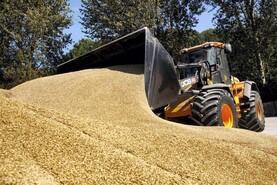One of the core concepts that the focus farms have engaged with is making high-quality grass silage to reduce winter feed costs. The first question on everyone’s mind is: how do we go about making high-quality silage?
Silage is a balancing act between quantity and quality. Maximum feed value would be realised by cutting it at the three-leaf stage and ensiling. However, with costs of ensiling upwards of £130/ha, the dry matter (DM) yield is not high enough to make this practical.
So what is the correct stage to cut at? A rule of thumb is that once a grass plant starts to push up flowering stems, the D-value will fall by 0.5 units per day.
This means that ear emergence drives decision-making for when to cut. Table 1 is taken from the AHDB publication Making grass Silage for Better Returns.
Grass varieties in Scotland are detailed on the Scottish Recommended List, available on the Farm Advisory Service website (www.fas.scot).
Each variety is rated based on its heading date, meaning that each variety in an average year will head at a known point in the season, relative to 1 May.
This means that for a known silage mix, it is quite easy to have an idea as to when the field will go to head.
Cutting date can then be decided based on what class of livestock are being fed.
Youngstock and pre-lambing ewes need to be getting fed on 70 D-value, high-quality silage, ie cutting at 25% ear emergence. Most of the focus farms are aiming for this early cut silage to reduce the amount of concentrates being fed – keeping the winter feed costs down.
However, some have dry, spring-calving cows on silage diets too. These animals do not need such high-quality silage and allowing the grass to bulk up and make silage in the low to mid 60s D-value makes more financial sense.
For those that have both dry cows and youngstock to feed, the ideal strategy is to take high-quality, highly digestible first-cut silage early in the season and then let the grass bulk up to make a lower-quality, second cut in late summer, giving a balance of both types.
Fertiliser
Deciding how much nitrogen to apply is driven by the fact that grassland will utilise 2.5kg of nitrogen per day under ideal growing conditions.
In colder, wetter weather, utilisation will be poorer. Where weather conditions have not been favourable in the run up to silage cutting, and you are unsure whether the grass has used all of the nitrogen that has been applied, it is prudent to have a fresh grass sample tested for nitrates before cutting.
High nitrogen or nitrate levels in silage crops can lead to high ammonia and low sugar levels, meaning a very poor fermentation of the silage. Where the results of a forage sample are borderline high, a successful 24-hour wilt will help to reduce nitrate levels. If a grass mix is likely to head around the end of May and we want to be cutting it at 25% ear emergence, we are looking at a cutting date of mid to late May. This means that in order to ensure that all the nitrogen is used in the growing period, applying 100kg/ha of nitrogen in early April will give maximum growth effect while still allowing a cutting date in the middle of May.
Fertilisation
Where silage ground is yet to be fertilised, you can still make high-quality, relatively early cut silage by reducing the total nitrogen applied to the crop.
An added benefit of an early first cut is the length of the season it leaves you with, allowing you to get a second cut and subsequent grazing for the rest of the year.
As can be seen, the potash offtake from a silage crop is quite large and in order to maintain soil fertility it is key to ensure this is replaced, either via dung and slurry or via fertiliser.
At the end of the day, making high-quality silage is a key measure to reduce winter feed costs.
When comparing the cost of silage against the cost of an average concentrate, silage is around half the cost per tonne of dry matter and if it is of good enough quality, it is more than able to replace the concentrate.
Adviser comment – Declan Marren
Livestock are beginning to appear in fields across the northeast of the country, as ground conditions are very good and grass growth has taken off. The forecast for the next week to 10 days is quite changeable, with cold weather this week being replaced with high pressure during the weekend – with expected temperatures into the high teens, prior to returning to more average temperatures for this time of year next week.
High variations in temperature, especially from warm days to cold nights, can cause a spike in pneumonia – especially where cattle are under stress. Keep a close eye on stock over the next few days and act fast if you suspect any issues.
Cattle with pneumonia will be lethargic, slow to get up and feed, ears may be low and the animal will look dull. Where autumn calves are to be weaned prior to turnout this spring, it would be best to avoid weaning over the next few days.
Nematodirus
With the expected rise in temperatures, the risk of a hatch for nematodirus also increases, with the SCOPS website forecasting a moderate risk in most areas of Scotland at the moment. Some actions you can take to reduce the risk is to move lambs to pastures that were not grazed by lambs last year. Treatment for netatodirus is carried out by using a white wormer – type I bendazole wormers. Remember it may be necessary to treat lambs more than once, depending on the age spread within the group and weather conditions over the next fortnight.
One of the core concepts that the focus farms have engaged with is making high-quality grass silage to reduce winter feed costs. The first question on everyone’s mind is: how do we go about making high-quality silage?
Silage is a balancing act between quantity and quality. Maximum feed value would be realised by cutting it at the three-leaf stage and ensiling. However, with costs of ensiling upwards of £130/ha, the dry matter (DM) yield is not high enough to make this practical.
So what is the correct stage to cut at? A rule of thumb is that once a grass plant starts to push up flowering stems, the D-value will fall by 0.5 units per day.
This means that ear emergence drives decision-making for when to cut. Table 1 is taken from the AHDB publication Making grass Silage for Better Returns.
Grass varieties in Scotland are detailed on the Scottish Recommended List, available on the Farm Advisory Service website (www.fas.scot).
Each variety is rated based on its heading date, meaning that each variety in an average year will head at a known point in the season, relative to 1 May.
This means that for a known silage mix, it is quite easy to have an idea as to when the field will go to head.
Cutting date can then be decided based on what class of livestock are being fed.
Youngstock and pre-lambing ewes need to be getting fed on 70 D-value, high-quality silage, ie cutting at 25% ear emergence. Most of the focus farms are aiming for this early cut silage to reduce the amount of concentrates being fed – keeping the winter feed costs down.
However, some have dry, spring-calving cows on silage diets too. These animals do not need such high-quality silage and allowing the grass to bulk up and make silage in the low to mid 60s D-value makes more financial sense.
For those that have both dry cows and youngstock to feed, the ideal strategy is to take high-quality, highly digestible first-cut silage early in the season and then let the grass bulk up to make a lower-quality, second cut in late summer, giving a balance of both types.
Fertiliser
Deciding how much nitrogen to apply is driven by the fact that grassland will utilise 2.5kg of nitrogen per day under ideal growing conditions.
In colder, wetter weather, utilisation will be poorer. Where weather conditions have not been favourable in the run up to silage cutting, and you are unsure whether the grass has used all of the nitrogen that has been applied, it is prudent to have a fresh grass sample tested for nitrates before cutting.
High nitrogen or nitrate levels in silage crops can lead to high ammonia and low sugar levels, meaning a very poor fermentation of the silage. Where the results of a forage sample are borderline high, a successful 24-hour wilt will help to reduce nitrate levels. If a grass mix is likely to head around the end of May and we want to be cutting it at 25% ear emergence, we are looking at a cutting date of mid to late May. This means that in order to ensure that all the nitrogen is used in the growing period, applying 100kg/ha of nitrogen in early April will give maximum growth effect while still allowing a cutting date in the middle of May.
Fertilisation
Where silage ground is yet to be fertilised, you can still make high-quality, relatively early cut silage by reducing the total nitrogen applied to the crop.
An added benefit of an early first cut is the length of the season it leaves you with, allowing you to get a second cut and subsequent grazing for the rest of the year.
As can be seen, the potash offtake from a silage crop is quite large and in order to maintain soil fertility it is key to ensure this is replaced, either via dung and slurry or via fertiliser.
At the end of the day, making high-quality silage is a key measure to reduce winter feed costs.
When comparing the cost of silage against the cost of an average concentrate, silage is around half the cost per tonne of dry matter and if it is of good enough quality, it is more than able to replace the concentrate.
Adviser comment – Declan Marren
Livestock are beginning to appear in fields across the northeast of the country, as ground conditions are very good and grass growth has taken off. The forecast for the next week to 10 days is quite changeable, with cold weather this week being replaced with high pressure during the weekend – with expected temperatures into the high teens, prior to returning to more average temperatures for this time of year next week.
High variations in temperature, especially from warm days to cold nights, can cause a spike in pneumonia – especially where cattle are under stress. Keep a close eye on stock over the next few days and act fast if you suspect any issues.
Cattle with pneumonia will be lethargic, slow to get up and feed, ears may be low and the animal will look dull. Where autumn calves are to be weaned prior to turnout this spring, it would be best to avoid weaning over the next few days.
Nematodirus
With the expected rise in temperatures, the risk of a hatch for nematodirus also increases, with the SCOPS website forecasting a moderate risk in most areas of Scotland at the moment. Some actions you can take to reduce the risk is to move lambs to pastures that were not grazed by lambs last year. Treatment for netatodirus is carried out by using a white wormer – type I bendazole wormers. Remember it may be necessary to treat lambs more than once, depending on the age spread within the group and weather conditions over the next fortnight.






 This is a subscriber-only article
This is a subscriber-only article










SHARING OPTIONS: